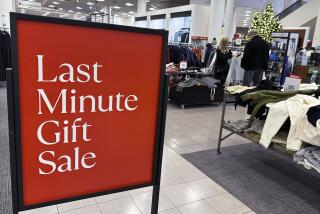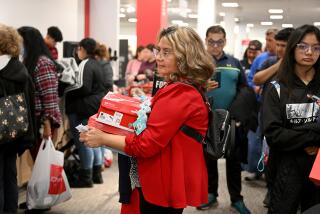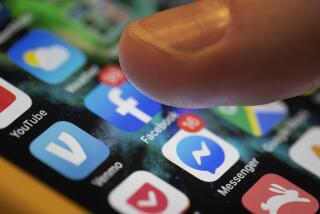Retailers are using mobile apps to drive up sales
Tia Smith clutched her new phone in one hand and a phone case in the other as she shopped at a West Hollywood Best Buy.
She clicked away into her smartphone’s tiny screen and searched for the case in other nearby stores.
“I’m trying to buy this Otter phone case for my new phone,” she said. “But I’m trying to see if Target or Wal-Mart has it for cheaper so they can honor the price match,” she said, as she scrolled through Target’s mobile site on her new phone.
As more people turn to their smartphones and tablets when they’re thinking about making a purchase, retailers and marketing companies are rushing to figure out ways to transform these mobile browsers into buyers. Some are providing special bargains. A few are tracking shoppers’ every move around the store and nudging them to seal the deal.
During the fourth quarter of last year, mobile devices were responsible for 16.6% of online sales, up from 11.4% in the fourth quarter of 2012, according to an IBM Corp. study. Tablets drove 11.5% of those sales compared with 5% from smartphones, IBM said.
“People are using smartphones and tablets on different occasions,” said Charlie Anderson, chief executive of Shoptology Inc., a marketing company. “They’re using the tablet at night when they’re on the couch or in bed and making purchases or doing research, and mobile is more for doing research while you’re in brick-and-mortar stores.”
Mobile shoppers are always on the lookout for a better deal, said Beth Craig, director of insight for Catapult, a marketing consulting company. In a study produced by Google Inc. last year, 44% of smartphone shoppers said they used mobile devices to shop because it saved them money.
Google’s search engine is popular for comparison shopping, as are a proliferation of mobile apps that can read bar codes and other coded product identifiers using a properly equipped smartphone.
The field is still relatively young, so consumer product companies and retailers are still figuring out how to attract these mobile shoppers, said Adam Guy, senior vice president of business development for Millward Brown, a market research company.
Several retailers also have turned to special shopping apps. Some are fairly basic, guiding customers to various departments within a store, cluing shoppers in on specials and enabling shoppers to make shopping lists and load coupons electronically.
Tools that provide promotional offers and digital coupons tend to be among the most popular methods of marketing on these devices.
“One of the problems with coupons is access. How many times do you go to a store and get to the counter and realize that you forgot your coupon?” Guy said.
Wal-Mart has released a more sophisticated mobile phone app that tracks a user’s location using the phone’s GPS and can offer in-store deals when it recognizes the shopper is in a store.
A few retailers are taking the concept even further.
In November, the Macy’s department store chain began testing a product called ShopBeacon at stores in San Francisco’s Union Square and New York’s Herald Square.
The app, created by Shopkick Inc. of Redwood City, Calif., enables a merchant to offer discounts on specific products that a customer has expressed interest in or, perhaps, has lingered near, prodding him or her to buy.
“We can find out where you are standing and how long you’ve been standing in front of the Michael Kors handbag and if you haven’t purchased,” Macy’s Chief Executive Terry Lundgren said at an analysts conference in November. “And if you haven’t, I’ll send you a little note to give you encouragement to do so.”
“It’s just like when you’re at home online and … you’re on a Macy’s page and you haven’t actually bought, we can come back to you and send you a little pop-up message. Well, now we can do that when you’re in our store, when you are thinking about purchasing and you’re not purchasing,” Lundgren said.
ShopBeacon, which uses sensors in a store to interact with Apple Inc.’s iBeacon location technology, began rolling out in January to 100 American Eagle Outfitters and Aerie stores in Los Angeles and other major cities. Shoppers are enticed to the opt-in technology not only by discounts but also the promise of rewards such as gift cards, music downloads and movie tickets, Shopkick said.
Although the use of mobile devices in shopping is growing, sales from phones and tablets remain relatively low.
Despite the most lucrative mobile shopping holiday on record in 2013, consumers left nearly $16 billion on the table in the form of lost mobile sales during that period, according to Jumio, a mobile payments and ID verification company. Poor mobile payment experiences drove almost half of consumers considering purchases to abandon them.
Consumers don’t like having to squint as they browse on their portable screens and aren’t hitting the tiny “click” button on their screen.
“Trying to search for things on this iPhone is like looking through a peephole,” said Scottie Slane, a musician who was using his phone to research an SD memory card he was interested in buying at a Best Buy in West Hollywood recently.
“You’ve gotta zoom and then scroll,” Slane said. “It’s inconvenient, so I’ll just do it at home.”
Twitter: @James_Barragan
More to Read
Inside the business of entertainment
The Wide Shot brings you news, analysis and insights on everything from streaming wars to production — and what it all means for the future.
You may occasionally receive promotional content from the Los Angeles Times.










